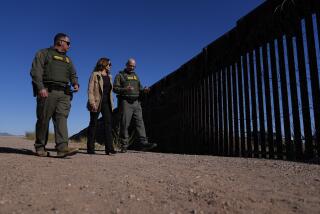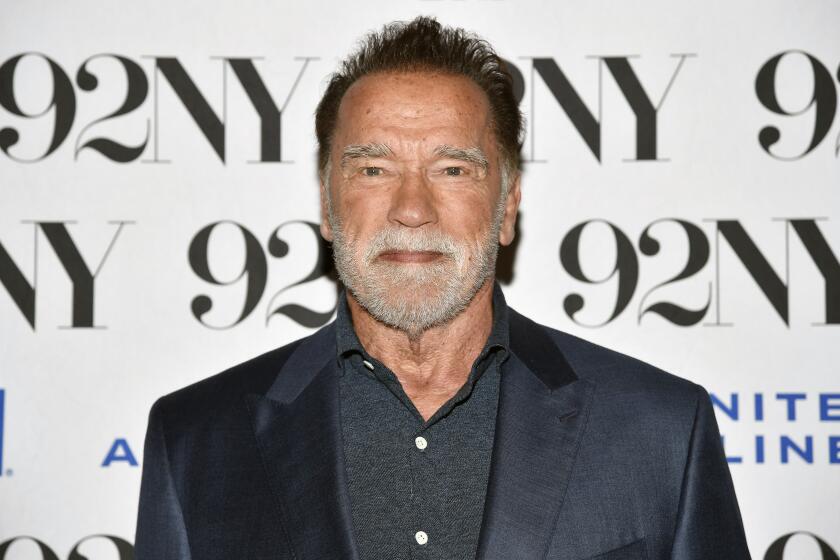As border crossings rise, Trump vents frustration on illegal immigration

President Trump’s administration released new figures on Thursday showing a surge in March in people caught crossing the border unlawfully
Reporting from Washington — President Trump reached back to some of his most visceral campaign rhetoric against illegal immigration on Thursday as his administration released new figures showing a surge in March in the number of people caught crossing the border unlawfully.
The new numbers come as Homeland Security Secretary Kirstjen Nielsen tries to make the case that National Guard troops along the southwest border are needed to contain a crisis, even as longer-term figures show that the number of illegal border crossings remains at the lowest levels since the early 1970s.
The plan to use National Guard units was arranged hastily after Trump — who has been frustrated with his inability to get Congress or Mexico to pay for a border wall — said publicly this week that he wanted to use the military to patrol the border until the wall is built.
Immigrant advocates and many Democrats have argued that the emergency is being manufactured to stoke Trump’s political base and demonize immigrants.
Trump told reporters aboard Air Force One on Thursday that he would send between 2,000 and 4,000 troops — a figure higher than the 1,200 deployed by President Obama in 2010 and lower than the 6,000 deployed by President George W. Bush in 2006.
Trump doesn’t fully control the numbers, however: Guard units are controlled by their states’ governors, and none of the four border-state governors have formally committed to specific deployments, in part because the federal government has not yet committed to pay the cost.
At the Pentagon, officials who briefed reporters struggled to answer questions about what the Guard troops would do or whether they would be armed.
“We’re going to coordinate” with Homeland Security officials and the governors, said Dana White, the Pentagon’s chief spokesperson. “They will provide us with the requirements, and then, from that, we’ll determine how many, and what’s the mission, and how many we’ll deploy.”
“Once we know the requirements, this department will move very quickly,” added Marine Lt. Gen. Kenneth McKenzie Jr., director of the military’s Joint Staff. “We haven’t been given a timeline.”
Asked whether the troops would carry weapons, McKenzie said, “Our advice is always that soldiers are able to defend themselves, and they have the right of self-defense. However, we’re going to be guided by the dialogue that’s going on now between DHS and the governors, and then we’ll work that here internally.”
Nielsen told Mexican authorities that the National Guard troops would not be armed or participate in immigration or customs duties, according to a Mexican Foreign Ministry statement released late Wednesday.
Can onetime Trump favorite Scott Pruitt save his job? »
Mexican President Enrique Peña Nieto planned to deliver a televised speech to an outraged nation Thursday night calling for national unity in the face of “offensive and unfounded statements concerning Mexicans.”
“We will not allow negative rhetoric to define our actions,” he planned to say, according to remarks released ahead of time. “We will only act in the best interest of Mexicans.”
Peña Nieto was not the only chief executive expressing frustration. Trump went on an extended tangent about immigration during a roundtable in West Virginia that was designed to showcase the Republican tax cut. He railed against illegal border crossers. He complained once again that California’s “sanctuary city” laws were protecting a lot of “really bad” people, said that Oakland Mayor Libby Schaaf should have been prosecuted for giving public warnings ahead of immigration raids earlier this year, and claimed, inaccurately, that other countries were stocking the visa lottery system with undesirable immigrants.
Trump also highlighted a well-documented problem — migrant women raped while traveling north toward the U.S. border — and seemed to suggest that it proved the accusation he made at the start of his presidential campaign that Mexico was sending rapists across the border into the U.S.
“Women are raped at levels that nobody’s ever seen before,” Trump said Thursday.
He added that MS-13 gang members on New York’s Long Island were using knives instead of guns to terrorize people “because it’s much more painful, where they cut people up … young girls walking home and their parents never see them again. They’re cut up.”
“This is the kind of stuff and crap that we’re allowing in our country,” he said.
One clue about what may have sparked Trump’s recent rhetorical flurry over immigration came as the Border Patrol announced the latest figures on arrests of people illegally crossing the border. Officials arrested 37,393 people in March, a 37% increase from February and more than double the number from March of last year, according to statistics released Thursday by the Department of Homeland Security.
The numbers remain quite low by historical standards, and border crossings typically rise in the spring. But the increase marked a reversal of the sharp downward trend in illegal crossings that took hold after Trump’s election. The fact that illegal crossings fell last year had been a proud boast for the administration. Overall, illegal border crossings for the last several have been at the lowest levels since the early 1970s.
Nonetheless, administration officials said the sharp increase from the previous month was cause for concern.
“The crisis at our southwest border is real,” said Nielsen, once again repeating the administration’s pitch to change immigration laws, fund Trump’s border wall and “gain operational control of the border.”
In recent years, most immigrants illegally crossing the border with Mexico have come from violence-wracked Central American countries. They include many families and children who often surrender themselves at the border and are, by law, released from detention while they pursue asylum claims.
In his West Virginia remarks, Trump repeated his claim that almost none of the people released from detention show up for their court hearings. In fact, a large majority of them appear on schedule, according to government figures.
Last month, border agents detained 8,882 asylum seekers in families and 4,171 unaccompanied minors — far more than in March 2017, when families and children together accounted for 2,167 apprehensions. Overall, the increase from the previous month was the greatest since 2011.
Because so many asylum seekers surrender voluntarily, it’s not clear how deploying National Guard troops will change the situation.
At the Pentagon, White, the spokesperson, emphasized that the National Guard would be in a support role, assisting the Customs and Border patrol. Planners are looking at sending National Guard units that can assist with aviation, engineering, surveillance, communications, vehicle maintenance, and logistics support, she added.
The officials provided no estimate for when troops will begin flowing to the border.
Although the Guard units will be mobilized by state authorities in each of the border states, it appears that the cost of the operation will be paid out of the federal budget. But White said where the money will come from had not been decided.
Pentagon officials are also looking at beefing up protection on military installations abutting the border, White said, including an Air Force bombing range in Arizona, where officials are looking at expanding a border fence.
Times staff writers Brian Bennett in Washington and Kate Linthicum and Cecilia Sanchez in Mexico City contributed to this report.
Follow the latest news of the Trump administration on Essential Washington »
Twitter: @noahbierman
More to Read
Get the L.A. Times Politics newsletter
Deeply reported insights into legislation, politics and policy from Sacramento, Washington and beyond. In your inbox three times per week.
You may occasionally receive promotional content from the Los Angeles Times.













